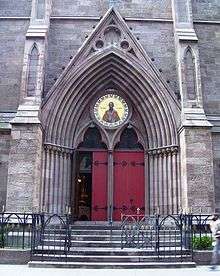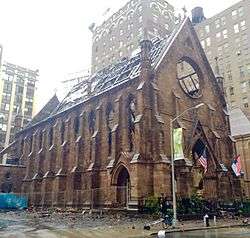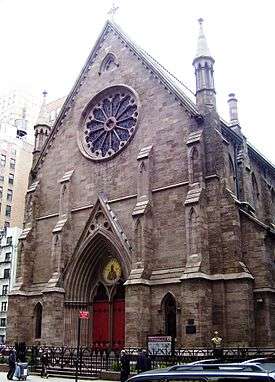Trinity Chapel Complex
|
Trinity Chapel Complex (Serbian Orthodox Cathedral of St. Sava) | |
|
(2011) | |
 | |
| Location |
15 West 25th St. Manhattan, New York City |
|---|---|
| Coordinates | 40°44′37″N 73°59′24″W / 40.74361°N 73.99000°WCoordinates: 40°44′37″N 73°59′24″W / 40.74361°N 73.99000°W |
| Built |
sanctuary: 1850-55 parish school: 1860 clergy house: 1866 |
| Architect |
sanctuary: Richard Upjohn parish school: Jacob Wrey Mould clergy house: Richard Upjohn & Richard M. Upjohn reredos & altar: Frederick Clarke Withers |
| Architectural style | Gothic Revival |
| NRHP Reference # | 82001205[1] |
| Significant dates | |
| Added to NRHP | December 16, 1982 |
| Designated NYCL | April 18, 1968 |
Trinity Chapel Complex, later the Serbian Orthodox Cathedral of St. Sava (Serbian: Црква светог Саве; Crkva svetog Save), is a historic church at 15 West 25th Street between Broadway and the Avenue of the Americas (6th Avenue) in the NoMad neighborhood of Manhattan, New York City.
The church building was constructed in 1850-55 and was designed by noted architect Richard Upjohn in English Gothic Revival style.[2] It was built as one of several uptown chapels of the Trinity Church parish, but was sold to the Serbian Eastern Orthodox parish in 1942, re-opening as the Cathedral of St. Sava in 1944.
The church complex includes the Trinity Chapel School, now the Cathedral's Parish House, which was built in 1860 and was designed by Jacob Wrey Mould, a polychromatic Victorian Gothic building which is Mould's only extant structure in New York City.[2] Attached to the sanctuary itself is the Clergy House at 26 West 26th Street, which was built in 1866 and was designed by Richard Upjohn and his son Richard M. Upjohn.[3]
The chapel was designated a New York City landmark in 1968,[4] and the complex was added to the National Register of Historic Places in 1982.[1]
Most of the church was destroyed in a four-alarm fire on May 1, 2016. In June 2016 reports had been circulated that the city of New York ordered that the remains of the structure be demolished, stating that the walls are too unstable to be allowed to stand.[5] The Buildings Department quickly clarified that the inspection was not complete and they had not ordered the immediate demolition of the building and instead is working with the parish to stabilise the structure. [6] [7]
Architecture

The outside is made of heavy exterior blocks of the building were etched in a rough finish, accented with austere Gothic trim and details. The front façade sits on West 25th Street and faces south. It measures around 65 feet (20 m) in width by roughly 100 feet (30 m) in height. The façade is supported by four stone buttresses, framed by delicate stone turrets at the sides, and punctuated by a large rose window above the entrance.[8]
Prior to the fire that took place May 1, 2016, the church was known to have had one of the largest timber hammerbeam roofs in the City of New York.[9]
History
Trinity Chapel
With the population of New York City moving ever-northward up Manhattan island in the mid-19th century, Trinity Church, the center of Episcopalianism in the city, needed to provide for its uptown parishioners, especially in the increasingly sought-after residential neighborhoods around Union and Madison Squares.[2] The church's solution was to build a chapel, named Trinity Chapel, on West 25th Street just off of Madison Square as an uptown annex.[10] The architect selected was Richard Upjohn, who designed the third and current version of Trinity Church, as well as the Church of the Ascension on Fifth Avenue and West 10th Street, as well as many other churches in the Gothic Revival mode in the northeast.
The parish was a wealthy and influential one, and Trinity was the only one of Trinity Church's chapels which was capable of supporting itself without assistance from the home church.[10] In 1865, in the Trinity Episcopal church was held an Orthodox liturgy for the first time in American history.[8] Among the congregants was writer Edith Wharton, who was married in the church in 1885.[3] In 1892, the reredos and altar were redesigned by Frederick Clarke Withers.[3]
Cathedral of St. Sava

By 1930, as the rich and influential continued their uptown migration, the neighborhood around Madison Square had seriously declined. The Chapel was now located within the Tenderloin, the city's main entertainment and red light district, and the congregation had dwindled. A Serbian Orthodox congregation, founded in the 1930s, purchased the building in 1942, with assistance from various Serbian churches, and the building re-opened in 1944 as a Serbian Orthodox cathedral dedicated to Saint Sava, the patron saint of the Serbs. The first pastor was Rev. Dushan Shoulkletovich.[10] Peter II, the last king of Yugoslavia attended services here.[10]
Gradual changes were made to the sanctuary to make it more Eastern Orthodox in style. A hand-carved oak iconostasis was added in 1962.[10][11] The Byzantine, hand-carved Iconostasis, brought from the Monastery of St. Naum in Ohrid, Yugoslavia, was placed in the Cathedral and blessed.[12]
The Icons on the Iconostasis were written by Russian iconographer, Ivan Meljinkov.[12]
When a bomb went off near the church on September 4, 1966[13] destroying some of the stained-glass windows, they were replaced with new ones commissioned in Byzantine style.[10][11]
His Holiness Serbian Orthodox Patriarch Pavle visited St. Sava Cathedral in October 1992. This was the first time the New York Church community was visited by a Patriarch.[12]
Outside the church are busts of Bishop Nikolai Velimirovich, who was instrumental in founding the parish, helped to organize the Serbian Orthodox Church in America, and was in later years the "luminary-in-residence" at the cathedral; Nikola Tesla, the inventor and entrepreneur; and Michael Pupin, a physicist of Serbian heritage.[3][10]
Prior to the fire of May 1, 2016 around $4 million had been spent on renovations to the cathedral's roof, gutters, and its attached community center in the past decade.[14] The church's ceiling was repainted during those renovations to depict a nighttime sky.[14]
2016 fire

On May 1, 2016, a massive fire occurred at the church, on the day Orthodox Christians were celebrating Easter, destroying most of the building.[15][16] The four-alarm fire started at 6:49 p.m. local time and was brought under control by 8:30 p.m.[17] employing more than 170 firefighters overall.[15][16][18]
There was one minor injury.[19]
The stone walls of the cathedral remain standing, and have been deemed to be structurally sound and not currently in danger of collapsing.[8][9] Church officials have indicated they will examine whether any part of the structure could be preserved.[20]
The parish house associated with the Chapel Complex was not harmed by fire.[21]
Aftermath
St. Sava parishioners reunited a few blocks away the first Sunday after the fire at Gramercy Park's Episcopal Calvary-St. George's Parish Church to worship.[22][23]
Church officials indicate there will be plans to rebuild at the current site.[22][23] Offers of support, including a letter from His Holiness Patriarch Bartholomew have been shared with the parishioners of the church.[24]
Serbia's outgoing Foreign Minister Ivica Dačić indicated that the City of New York would be asked through diplomatic channels to aid in the rebuilding of the church. He also indicated Prime Minister Aleksandar Vučić authorized him to say that the government will help rebuild the church, "because it has great significance for the Serbian community and the Serbian spirit in New York."[25]
As of two days after the fire, the definitive cause of the fire had not been determined. Candles that had not been properly extinguished after an Easter service were identified as a likely cause, according to a spokesperson of the New York City Fire Department (FDNY). A caretaker told fire marshals that he stowed the candles in a cardboard box under a piece of wooden furniture in a rear corner of the 161-year-old church.[26][27]
Nearly a month after the fire FDNY spokesman Frank Gribbon indicated conclusively that, "Fire marshals have ... determined that candles, which had not been completely extinguished, caused the fire."[28] The city has ordered the remains of the church demolished, calling them unstable.[5]
The Buildings Department quickly clarified that the inspection was not complete and they had not ordered the immediate demolition of the building. [6] In August 2016 the parish announced that the Building Department ordered metal beams be used to shore up the walls and the building be covered with a waterproof canvas to keep it from being damaged further by the elements. The parish announced they anticipate that effort to be completed in September 2016. [7]
References
- 1 2 National Park Service (2009-03-13). "National Register Information System". National Register of Historic Places. National Park Service.
- 1 2 3 New York City Landmarks Preservation Commission; Dolkart, Andrew S. (text); Postal, Matthew A. (text) (2009), Postal, Matthew A., ed., Guide to New York City Landmarks (4th ed.), New York: John Wiley & Sons, ISBN 978-0-470-28963-1 p.80
- 1 2 3 4 White, Norval & Willensky, Elliot (2000), AIA Guide to New York City (4th ed.), New York: Three Rivers Press, ISBN 978-0-8129-3107-5 p.199
- ↑ New York City Landmarks Preservation Commission (April 18, 1968). "Serbian Orthodoc Cathedral of St. Sava and Clergy House and Parish House Designation Report" (PDF). Retrieved May 2, 2016.
- 1 2 Singla, Vinita; Gonen, Yoav; Perez, Chris (14 June 2016). "Scorched cathedral to be demolished over safety concerns". Retrieved 15 June 2016.
- 1 2 Dunlap, David W. (2016-06-14). "New York Serbian Church Gutted by Fire Won't Be Demolished, for Now". The New York Times. ISSN 0362-4331. Retrieved 2016-08-12.
- 1 2 "Serbian Orthodox Cathedral of Saint Sava". stsavanyc.org. Retrieved 2016-08-12.
- 1 2 3 Ogorodnikov, Vitali (May 3, 2016). "Mourning the Landmark Serbian Orthodox Cathedral of St. Sava, 15 West 25th Street, Gutted by Four-Alarm Blaze on Easter Day". New York YIMBY. Retrieved May 4, 2016.
- 1 2 Rosenberg, Zoe (2016-05-02). "Fire at Landmarked Flatiron Church Is Out, But Origin Remains Unclear". Curbed NY. Retrieved 2016-05-03.
- 1 2 3 4 5 6 7 Dunlap, David W. (2004). From Abyssinian to Zion: A Guide to Manhattan's Houses of Worship. New York: Columbia University Press. ISBN 0-231-12543-7., p.244
- 1 2 Miller, Tom (2010-11-03). "Daytonian in Manhattan: Richard Upjohn's 1851 Trinity Chapel -- The Serbian Cathedral of St. Sava". Daytonian in Manhattan. Retrieved 2016-05-03.
- 1 2 3 "History of the Cathedral of St. Sava in New York". Serbian Orthodox Cathedral of St. Sava. Retrieved May 2, 2016.
- ↑ King, Seth (September 5, 1966). "Bomb Damages Red Offices and a Cathedral Here - Bomb Damages Red Offices and Cathedral Here". The New York Times. Retrieved May 3, 2016.
- 1 2 Kanno-Youngs, Zolan (2016-05-03). "Congregation Mourns Serbian Orthodox Church Destroyed by Fire". Wall Street Journal. ISSN 0099-9660. Retrieved 2016-05-05.
- 1 2 Staff (May 1, 2016). "Huge blaze engulfs Serbian Orthodox Church in Manhattan on Easter Sunday". Russia Today. Retrieved May 1, 2016.
- 1 2 Rosario, Frank; Sullivan, C.J.; Wilson, Tom & Perez, Chris (May 1, 2016). "Massive fire breaks out at Manhattan church". New York Post. Retrieved May 1, 2016.
- ↑ Kapp, Trevor; Cuilliton, Kathleen; Nichols, Adam & Gardiner, Aidan (May 2, 2016). "Massive Fire Rips Through Historic Serbian Orthodox Cathedral". DNAinfo New York. Retrieved May 3, 2016.
- ↑ Mai, Andy & Annese, John (May 1, 2016). "Firefighters battle blaze at Manhattan church". New York Daily News. Retrieved 2016-05-02.
- ↑ Associated Press (May 1, 2016). "Firefighters Contain Huge Fire at New York City Church". ABC News. Retrieved May 2, 2016.
- ↑ Cohen, Shawn & Perez, Chris (May 10, 2016). "Church head wants FBI to take over fire investigation". New York Post. Retrieved 2016-05-13.
- ↑ Мишић, Милан. "Црква осигурана, али то неће надокнадити штету". Politika Online (in Serbian). Retrieved 2016-05-19.
- 1 2 "Manhattan Serbian Orthodox church holds first service since fire". NY Daily News. Retrieved 2016-05-13.
- 1 2 Remnick, Noah (2016-05-08). "After a Manhattan Church Is Destroyed in a Fire, Another Welcomes Its Members". The New York Times. ISSN 0362-4331. Retrieved 2016-05-13.
- ↑ "Serbian Orthodox Cathedral of Saint Sava". stsavanyc.org. Retrieved 2016-05-13.
- ↑ "Dacic tours Serbian church in NYC destroyed in Easter fire - - on B92.net". B92.net. Retrieved 2016-05-19.
- ↑ Kilgannon, Corey (2016-05-03). "Candles May Have Caused Fire That Gutted Serbian Church, Officials Say". The New York Times. ISSN 0362-4331. Retrieved 2016-05-04.
- ↑ Signore, John Del. "Some Fear "Apocalyptic" Manhattan Church Fire May Be Connected To Other Church Fires". Gothamist. Retrieved 2016-05-04.
- ↑ Cohen, Shawn & Perez, Chris (June 3, 2016). "Tragic cathedral fire sparked by Easter candles". New York Post. Retrieved 2016-06-07.
External links
| Wikimedia Commons has media related to Serbian Orthodox Cathedral of St. Sava (Manhattan). |
- Official website
- Trinity Chapel records at Trinity Wall Street Archives
- Cathedral of St. Sava
- Trinity Chapel, Edith Whartons New York, January 20, 2013
